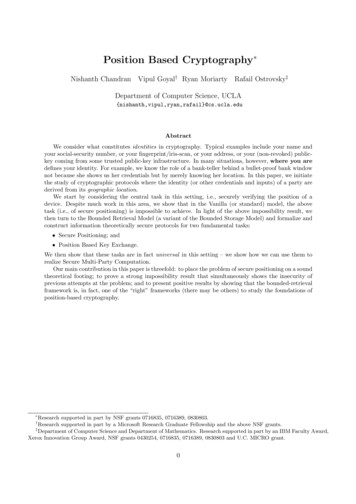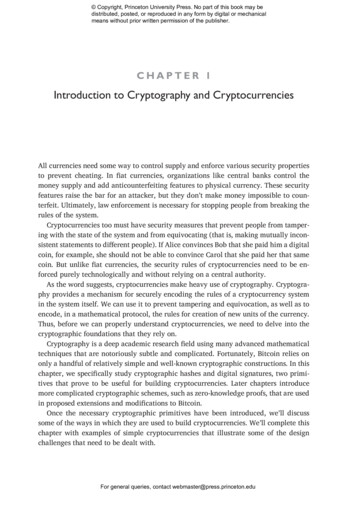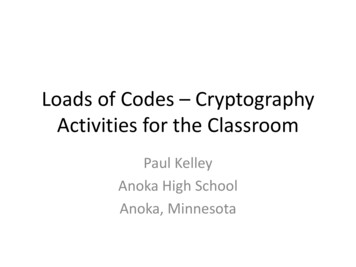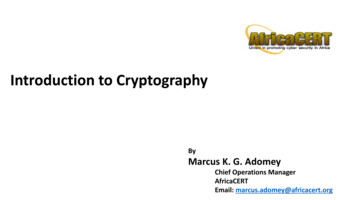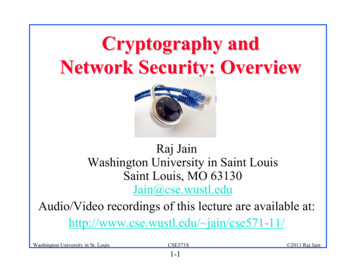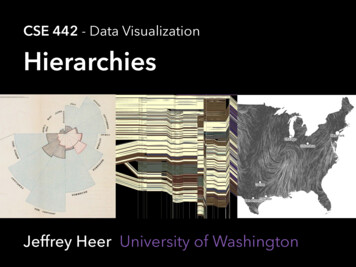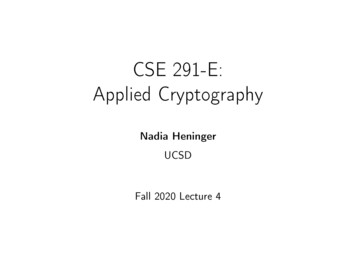
Transcription
CSE 291-E:Applied CryptographyNadia HeningerUCSDFall 2020 Lecture 4
Legal NoticeThe Zoom session for this class will be recorded and made availableasynchronously on Canvas to registered students.
Announcements1. HW 1 is due today! Turn it in now if you haven’t yet!2. HW 2 is out, due before class in 1 week, October 20.
Last time: Block ciphersThis time: Pseudorandom functions and chosen plaintext attacks
Pseudo-random functions (PRFs)Truly Random FunctionDeterministic algorithm F : k 2 K, x 2 X, y 2 Y Fk (x) y Should be computationallyindistinguishable from a trulyrandom functionIn contrast to the(pseudo)random permutationsfrom last lecture, this function isnot required to be one-to-one.
Distinguishing experiment for PRFsDefinitionFk is a secure PRF if 8 efficient D Pr[D(Fk ) 1]Pr[D(random fn) 1] negligible
Is a PRP indistinguishable from a PRF?Consider a distingushing experiment between functions andpermutations.Observation: The only way to distinguish between a permutationand a non-permutation function is to find a collision, inputs so thatf (x1 ) f (x2 ).Let X N. By the birthday bound, the adversary will observep acollision in outputs in a PRF with constant probability after Ninputs.TheoremifAn adversary that makes Q queries can distinguish a randompermutation from a random function with probability at mostQ 2 /2N.
Constructing PRGs from PRFsTheoremLet x1 , . . . , x be fixed, distinct elements, and F be a PRF.G (k) (Fk (x1 ), Fk (x2 ), . . . , Fk (x ) is a secure PRG.Proof.Assume for contradiction that adversary AG can distinguish thisPRG from random. Can construct a distinguisher AF for the PRF.
Counter ModeIn the previous construction x1 , . . . , x just need to be distinctelements. So just choose r and let x1 r , x2 r 1, . . . .strewn :Fico Fichte ) Edric),,.Then we can use this as a stream cipher to encrypt:Enck (m) (r , Fk (r )Deck (c) (Fk (r )m[0], Fk (r 1)c[0], Fk (r 1)This is semantically secure.m[1], . . . , Fk (r )c[1], . . . , Fk (r )m[ ])c[ ])
Attack models we’ve seen so far:Ciphertext-only attack Most restrictive attack modelKnown plaintext attack Historical example: WWII Enigma-encoded messages fromGermans ending in “Heil Hitler” Modern example: Observing ciphertext from someone visitingthe main page of Wikipedia over HTTPS.Both of these are covered by semantic security.New attack model:Chosen plaintext attack Historical example: British military would place mines inparticular locations hoping Germans would send encryptedmessages about that location. Modern example: Attacker-controlled Javascript on a webpage causes victim web client to make a HTTPS connection.
Chosen plaintext attackDefinitionEnc is CPA-secure if 8 efficient A, Pr[A succeeds] 1/2 for negligible
Another definition of chosen plaintext attackDefinitionEnc is CPA-secure if Pr[A outputs 1 b 1]Pr[A outputs 1 b 0] negligible
TheoremNo deterministic cipher can be CPA-secure.CA I'to
TheoremNo deterministic cipher can be CPA-secure.Proof.Adversary queries (m0 , m1 ) then (m0 , m0 ).
Using a PRF for CPA-secure encryption Generate k at random. Encryption:1. Generate r uniformly at random.2. Enck (m) (r , Fk (r ) m) Decryption:1. Parse c (r , s)2. Deck (c) Fk (r )s.
TheoremThe Enck (m) (r , Fk (r )CPA-secure.Proof.m) construction on the previous slide isBy contradiction. Assume adversary A can win CPA-security game#1 with non-negligible advantage, construct a PRF distinguisher.
( PRCA l FfProof.-THAII nestgateAssume A distinguishespseudorandom F with advantage d negl.winsCPA1. If F pseudorandom, Pr[A succeeds] 1/2 d2. If F is a truly random function f : A makes Q oracle queries.- If nonce rc used in challenge is repeated, A learns value off (rc ) and succeeds with probability 1.Pr[rc repeated across oracle queries] Q/2n- If rc not used in challenge, no information: Pr[success] 1/2Pr[A succeeds] 1/2 Q/2n Pr[D Fief ] Pr[D fFk ] 1/2 d (1/2 Q/2n ) d Q/2n negl.
Using stream ciphers in a CPA-secure wayAugment stream cipher with an initialization vector or IV. Enck (m) (IV , G (k, IV )m)For this to be secure, G (k, IV ) needs to be pseudorandom when IVis known.Insecure if IV is ever reused.WEP insecurity. WEP is broken in multiple ways: it uses a 24-bitIV, which repeats with 50% probability after 5,000 packets.
Extension: Randomized Counter ModeIf we use a block cipher in counter mode with a randomizedstarting value r , this is CPA-secure.m[0], Fk (r 1)Enck (m) (r , Fk (r )Deck (c) (Fk (r )c[0], Fk (r 1)m[1], . . . , Fk (r )c[1], . . . , Fk (r )The value r is the IV.This is an ok choice of mode of operation for AES.m[ ])c[ ])
Cipher block chaining (CBC) mode1. IV has same length as block length.2. ci Enck (ci1mi )3. Output (IV , c0 , c1 , c2 , . . . ).IV should be random.CBC mode is CPA-secure, but suffers from implementationvulnerabilities that you get to break in HW 3.
HW 2 is due before class in 1 week, October 20.
Using stream ciphers in a CPA-secure way Augment stream cipher with an initialization vector or IV. Enck(m) (IV,G(k,IV)m) For this to be secure, G(k,IV) needs to be pseudorandom when IV is known. Insecure if IV is ever reused. WEP insecurity. WEP is broken in multiple ways: it uses a 24-bit IV, which repeats with 50% probability after 5,000 .

